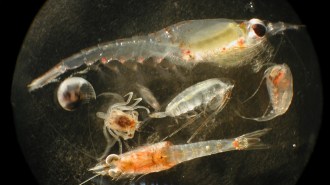Laboratory experiments investigating the crystal structure of iron-silicon alloys at hellish temperatures and pressures may yield new insights into the mineral composition of Earth’s solid, inner core, scientists say.

Iron is by far the most abundant chemical element at the center of the planet. The travel times of seismic waves passing through Earth’s liquid outer core–the only probe that scientists can use to survey that deep below Earth’s surface–suggest that material there is only about 90 percent as dense as pure iron would be at those pressures and temperatures. The lower density must result from a smattering of lighter elements such as carbon, oxygen, sulfur, or silicon, says Dion L. Heinz, a geophysicist at the University of Chicago.
To extrapolate to Earth’s inner core, Heinz and his colleagues recently studied alloys of iron and silicon at temperatures up to 2,100C and pressures exceeding 800,000 times atmospheric pressure at sea level. They found that even tiny amounts of silicon had significant effects on iron’s crystal structure under such extreme conditions.
At temperatures and pressures found at Earth’s surface, pure iron has a structure called a body-centered cubic crystal. In such an arrangement, eight atoms form the corners of a cube with a ninth atom in the center. At pressures of about 10 gigapascals–nearly 100,000 times atmospheric pressure at sea level–this relatively open structure collapses, and the iron atoms become more densely packed. In this compact, so-called hexagonal, close-packed structure, atomic groupings resemble the arrangement and spacing of oranges stacked in a pyramid at the grocery store.
The new experiments show that when small amounts of silicon–as little as 4 percent by weight–are mixed into the iron, the resulting alloy’s crystal structure remains stable up to 84 gigapascals. Under similarly pressing conditions, alloys prepared with larger proportions of silicon separate into a mix of relatively silicon-rich crystals with the body-centered cubic structure and silicon-poor zones with a different atomic arrangement.
The team presents its findings in the Jan. 11 Science.
According to previous research, up to 3 percent of the mass of Earth’s inner core may be composed of elements lighter than iron, says Heinz. The new data suggest that the core could be either one gargantuan crystal of silicon-tainted iron with a hexagonal close-packed structure or a blend of iron-rich minerals that includes body-centered cubic crystals.
The researchers’ findings confirm that even small amounts of impurities can substantially influence the crystal structure of a material at extreme temperatures and pressures, says Ho-kwang Mao, a geophysicist at the Carnegie Institution of Washington (D.C.). Future studies of iron alloys that include other light elements suspected to be common deep within the planet may yield more clues about the mineralogy of Earth’s core, he notes.







